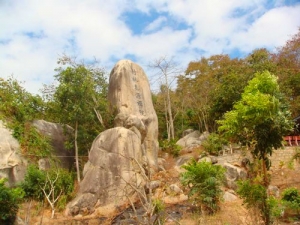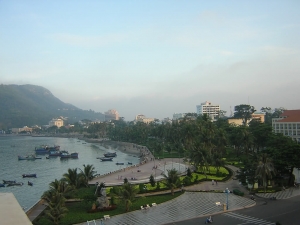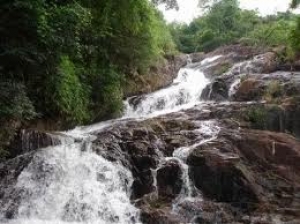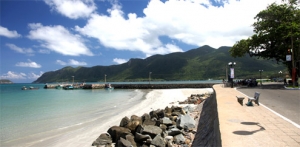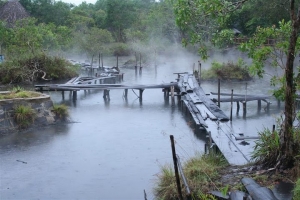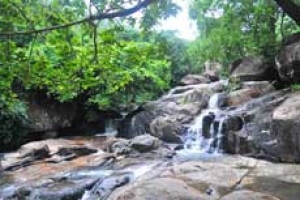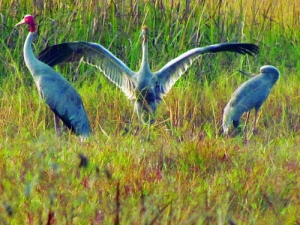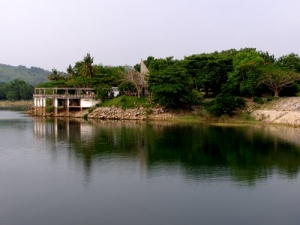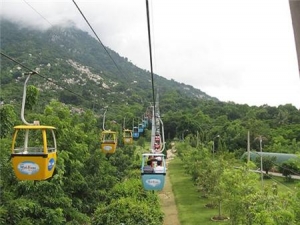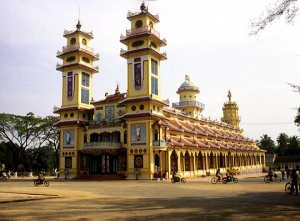
Asia Pacific Travel Team
Funny trip to Monkey pagoda, Vung Tau
Monkey pagoda lies at the bottom of Ky Van Mountain, belongs to Long Hai Town, Long Dien District, Ba Ria - Vung Tau Province. Besides natural beauty, the fascinating things are funny monkeys, raised in the natural environment on the Kỳ Vân mountain behind the pagoda.
The pagoda has correct name Nguyen Chon Monastery. Because of raising so many monkeys, it is known as the Monkey pagoda. These smart animals usually live wildly in the mountains. Over 10 years ago, Abbot Thich Thong Luan treated some mokeys which go down the pagoda to mump. Until getting acquainted, they go down the mountain every day. At first the number was not much, it is now up to nearly 200.

Tourists Vietnam tourism in come here often bring bananas and other fruits to feed the monkeys before seeing landscape. Stand out among thousands of green trees, the rock masterpiece from the tectonic nature will make visitors surprised and interested. A rock shaped “snake holds gem in mouth” symbol of prosperity, a large rock shaped like the Buddha statue reminds the peace; a different platform like a giant elephant into submission, a hundred years old tree, foot and roots crowd in rock cave recalled the Konia tree in Highlands …, all made the unique pagoda that nowhere can have.

In spring, the road from Long Hai town filled with pink and white brilliant blossoms peach.
This is an interesting ecology tourism place where many travelers in Vietnam travel like to chose it as a stop place in Long Hai tour.
Vung Tau - A place for the convergence of beautiful beaches
As not far from Ho Chi minh city, only travelling about 125 kilometers, Vung Tau city is located in the peninsula of the name same. This is the border of the South and the West of Vietland, where we can see the sun on the East Sea, both sunrise and sunset.
The first beach is front beach (Bãi Trước in Vietnamese), in the West of the city, where the sun goes down. The Front Beach is considered the façade of Vung Tau city. It is also called by other names such as Tam Duong beach or Hang Dua bay. Besides the best location, the beach is also preferred for having many restaurants and elegant hotels. Sparking, colorful and bright light boulevard make the Front Beach more beautiful.

Front Beach (Bãi Trước)
Opposite to the Front Beach is, Back beach (Thuy Van beach or Bãi Sau in Vietnamese). Back Beach is well-known for its over 10 kilometers of fine sand seaside. The beach is always excited and busy with almost tourists both from the city itself and the world. At weekends or on holidays, thousands of people often come here for swimming and entertainment. In the Back Beach, there is a popular kind of entertainment: Paradis, the upgraded swimming and relaxing area, and a system of modern hotels, welcoming all tourists joining tours to Vietnam. Other beautiful beaches are Pineapple Beach (Bãi Dứa) and Mudberry Beach (Bãi Dâu).
Back Beach (Bãi Sau)
From the Front Beach, Halong street curls to the Pineapple Beach. The reason for placing that name dated a long time ago, when the beach had many pineapple trees, thus it was called Pineapple garden. Many Vung Tau people also call the beach Lang Du, which originated from the local’s first restaurant’s name.
Right in here, the sea goes far into the land and the rock mountain goes from the land to the sea establishing romantic and hidden small beaches. The beach attracts a lot of tourists. Nearby, the Temple of Southern sea Saint and Tinh Xa nirvana are attractive tourist sites, which were built on one of these rock mountains.
Mudberry Beach lying in the North of the city is at the foot of Nui Lon. There used to be a lot of mudberry and ratten so it is also named Ratten beach. Nevertheless, today, there is no longer any mudberry and ratten. So now, when talking about Bai Dau, people think of a windless and rocky beach. Tourists in Vietnam travel should walk on about a few meters to see a 30m-high statue of Mother Maria shining in the green picturesque forest and sea landscape.
If you are searching the tourism information from Vietnam Travel Companies in the Internet and make a plan to visit Vietnam in the near future, I myself advises you not to pass Ba Ria- Vung Tau where many beautiful beaches are converged. You can spend your time and enjoy your good vacation trip here.
“The second Dalat in Vietnam”- The Fairy Stream in Ba Ria-Vung Tau
About 7 kilometers North-West of Ba Ria Town and originating from Dinh Mountain in nearly 500m-height, the Fairy Stream located in Tan Thanh district is called “the second Dalat in Vietnam” for its beautiful natural landscape.
Accompanied by the legend in the past, fairies would come here to bathe before returning to heaven. The trace of a delicate foot print, in a rock on a peak of Dinh Mountain, may have initiated this legend.
From hundreds of meters height, the Fairy Stream falls down the rocky mountain, runs tortuously, and irrigates fields before dissolving in Thi Vai River. The Fairy Stream has natural and pristine beauty, which makes unforgettable impressions on tourists’ mind although they just have come here the first time. Along both banks of the stream are large and even rocks which tourists in Vietnam tourism can sit to rest or enjoy the view. In addition, there are many granite stones covered with moss and lichen.
More especially, standing in anywhere, tourists joining tours in Vietnam still hear the sound of the stream falling down from the top of mountain and forming rather deep wells with blue water. The stream has white spume in the rainy season but becomes the ideal place for swimming in the dry season.
Getting to the Fairy Stream, tourists in Vietnam travel should go along trail to visit small pagodas, hear sound of pagoda bell and smell incense mingled with fragrant perfume of tuberose and magnolia. It's one of Fairy Stream's specific functions.
Con Dao stunning in visitors’ eyes in Vietnam Tourism
Con Dao is not only the biggest archipelago in Ba Ria- Vung Tau province, but it is also the most famous one in Vietnam tourism. This archipelago contains 16 islands with the total size of 76 square kilometers, and Con Lon island is the largest among them. Con Dao is notable for its paradoxes, namely one of very few “Hell on Earth”- an evidence of a woeful but noble period of Vietnamese history on Con Dao islands, but nowadays Con Dao islands have become a paradise for both domestic and international visitors joining tours in Vietnam. This abnormal combination explains for astonishing looks at the island: the beauty of nature and the evilness of human.
The noted place in Con Dao is Con Dao prison – the place to jail prisoners in Vietnam War. Compared to Phu Quoc prison, Con Dao prison was still left behind in terms of torturing method variety, but it is well-known for a much longer history. Established in 1862 by French Colonists, Con Dao since then is known as a “Hell on Earth”; anyone arrested there would surely suffer the death painfully.
From 1862 to 1975, Con Dao captured and detained thousands of prisoners, mostly patriots. Con Dao prison conjures up a dark memory that makes everyone trembling when reminding of the past. In Con Dao, the French Colonists and American Army have built a system of torturing, beating and killing prisoners very slowly and painfully. They established some special departments to easily torture prisoners.

Female revolutionaries were sent to the Tiger Cages without water to bathe and lime and waste were poured onto them.

The most famous one is separated “tiger cages”, which once shocked American public in 1970s, with unbelievable methods applied to prisoners. These tiger cages are small basements built by stone with steel window on the top, with the aisles between basements for jailers and soldiers to guard and insult prisoners with dirty water and lime. Jailers even invented “sunbathe room”, known as the tiger cages with no roof to force people inside to suffer from the sun heat for days. Another noted invention is separated cow sheds, which had been used to keep cow inside, but jailers transformed them into rooms for prisoners. They kept prisoners among animals with very poor conditions.

After being tortured, prisoners had to stay out in the sun and rain.
More terribly, they sent some “dangerous” prisoners to the basements under the sheds and let them rot away due to the waste from the animals. Prisoners here were chained with cuffs all the time, and the foods was just enough for them to survive. The jailers beat prisoners whenever they wanted, and tortured them by different methods that could not be seen anywhere else, including taking teeth, nailing into body, burning, etc. Con Dao nowadays has become a dreadful museum for people to visit, but it still attracts many tourists to witness the remaining of the evilness of human. It could be a useful and interesting history lesson for all adventurous tourists.
After 36 years of liberation, Con Dao archipelago is extremely stunning in tourists' eyes with green grass field, beautiful rivers, high mountains, lovely climate and fresh air; it is a poetic picture of natural beauty. Opposite with the trembling fears from Con Dao prison, the wildlife of Con Dao brings peace and comfort to tourists in Vietnam travel.

Con Dao has now become a paradise for visitors in Vietnam tourism.
Binh Chau Hot Spring - An attractive destination for ecotourism in Vietnam
About 150km from Ho Chi Minh City, Ba Ria-Vung Tau Province has such a wonderful thing. The Binh Chau Hot Springs, in Xuyen Moc District's Bung Rieng Commune, cover an area of about 33ha, enclosed by forest and sea. In 1928, a French doctor named Sallet discovered the hot mineral spring in his survey of southern Vietnam, where a cluster of 70 visible gushers spout water at temperatures ranging from 40oC to 82oC, forming a huge natural pool of hot water and mud.
With a view to develop a tourist attraction, provincial began to develop the Binh Chau Hot Mineral Springs in 1988, and their efforts were recognised in 2003, when the World Travel Organisation named Binh Chau as one of its 65 sustainable eco-tourism developments in 47 countries and territories around the world.
Walk on the wooden corridors through the flowing springs of the Sai Gon-Binh Chau Resort, and you can feel the stimulating atmosphere of fresh air laced with steam and the fragrance of the forest underneath the leafy canopy. The view is miraculous in the morning, as the steam covers the natural scenery in a thin dew.
The resort includes sports and recreation facilities for tourists on weekends, such as golf, volleyball, a swimming pool, a romantic Moon Garden and a thousand-seat theatre. Crocodile feeding, river fishing, billiards, tennis, basketball, and badminton complete the card at the Sai Gon-Binh Chau Resort, and younger visitors can visit the children's playground.
In the vicinity of Binh Chau, tourists can travel by foot or wagon to Bang Spring, about 2km away, or visit the zoo with its menagerie of bears, monkeys, weasels, geckos and eagles.
Most tourists in Vietnam travel who come to Binh Chau enjoy the fun of boiling eggs in the natural 80-degree springs in just ten minutes. Guests can buy eggs and lower them into small hot pools built by the developer for the purpose.
After the fun with the eggs, there are hot mud baths, soaks and massage services that are all therapeutic. According to researchers who tested the springs in 1975, the hot mineral spring source contains silica, sulphur, sodium and chlorine, all of which have healing properties and can aid rheumatism and circulation.
Sarah Elaine from the UK decided a little pampering was in order after a busy year, and she decided to visit the hot springs. She intended a day trip, but when she came, she realised that there wasn't enough time to enjoy all wonderful things at the site."I was glad to get into the hot spring to sort myself out and at least look as wet as everyone else," she said. "The resort was quite because of the rainy season. The hot springs were wonderful and I spent the rest of the day soaking, having a massage and eating some very good tamarind fish broth."
Legend describes the thermal springs as a hot water pot that the Vietnamese "Goddess of Boiling Water" spilled into the place in anger after her husband went hunting and was a long time returning. She got angry and threw the boiling water pot away, and it became the marvellous stream of hot water still running now.
Binh Chau area is also a wonderful place to hold retreats and team-building activities.
As the curtain of night covering Binh Chau fell, geckos and crickets began their symphony on a stage of forest and mountains.
The wonderland of Suoi Da (Rock Stream) in Ba Ria Vung Tau
Tourist in Vietnam tourism should not ignore the poetic beauty of Suoi Da (Rock Stream) which begins at Dinh Mountain in Tan Thanh District, Ba Ria-Vung Tau Province.
How to get there?
If you are from Ho Chi Minh City, you can head onto Hanoi Highway before passing Dong Nai Bridge and take a turn on National Road No.51 to Ba Ria-Vung Tau Province for 40 kilometres, and then you will see the small road to the stream. There are many paths to the mountain’s foot but the easiest way to remember it is when tourists pass Chu Hai Church, ride along the road for two kilometres where there are a number of small houses, vegetable gardens and onion farms along street sides. Then you will see the mountain’s foot, park your vehicle and then walk to Suoi Da Stream.
Tourists coming here will be impressed by this destination where there are many rocks of various sizes lying on the banks, forming into many smaller waterfalls. Tourists can rest on big and smooth rocks as they relax and admire the wonders of nature and talk with friends as they watch the rocks form into lakes. Locals say that from the foot to the peak of the mountain, there are five lakes that they number from 1 to 5. In scorching summer days or weekends, visitors flock to the lakes to swim in the cool water. Some young boys often jump from the mountain wall to the lake at a height of two meters and amidst the white bubbles they laugh so much as they revel in the joyous relationship between nature and humans.
Suoi Da is still non-resident so tourist services consist of small cottages for tourists to rest and enjoy food. Some vendors also come to sell snacks and drinks.
For tourists in Vietnam tourism, the ideal time to come to the stream is around 9 a.m. After swimming, tourists can take a rest and then have lunch. Later they can walk on the rocks along the stream as they bid to trek up the mountain. There are many old pagodas for tourists to visit on the way up.
Tourists should go home before 5 p.m. as it’s very dark in this area at sunset and there is no accommodation for travellers.
Lo Go- Xa Mat National Park
Covered about 18.765ha area, situated at 5-10m in hight over sea level, Lo Go – Xa Mat National Park is the region’s largest forest cover in the province of Tay Ninh divided into three zones. Particularly, the strict protection zone is 8.590ha, ecological restoration area: 10,080ha remaining administrative service areas.
Lo Go – Xa Mat vegetation mosaic of forest types between the semi-deciduous forest, deciduous forest on the narrow strip of lowland and evergreen forests along rivers and streams and mangrove forests. Near the border with Cambodia is a land of wide grassy marshes with sedge mats strabismus.
The flora is rich value such as legumes: water oil, oil sands, oil bottles, oil and her song, so dark, candle latex, some species have been named in the Red Book such as typing te, Christmas flavor, milk desert.
Bird fauna in this park is unique, in the wetland habitats have been recorded many species of rare water birds like giang sen, this old and small labels, pheasant feathers purple, red chicken cash, shots chach gray cheeks. In addition, Lo Go – Xa Mat also stop flying the red-headed crane species, the migratory routes of breeding sites in Cambodia. Lo Go-Xa Mat is recognized as one of the important bird areas in Vietnam.
The park boasts a mosaic of lowland evergreen forest area with a variety of wetland habitats, including seasonal flooded grasslands and forests, permanent lakes, and watercourses. Great efforts have been made to develop and preserve the fragile ecosystem, especially for several rare bird species.
It is not only an exciting tourist destination, but many researchers also come to the area to study the park and its animal inhabitants. According to researchers, Lo Go-Xa Mat supports important populations of Germain’s Peacock Pheasants (Polyplectron germaini) and Siamese Firebacks (Lophura diardi). The area serves as a stop-over for Sarus Cranes (Grus antigone) migrating between the Mekong Delta and Northern Cambodia.
Visiting the largest irrigation reservoir in Vietnam
Dau Tieng Lake’s beautiful scenery of mountains, its mysterious islets, and its fresh and pure atmosphere shall give visitors an agreeable feeling. Tourists shall also appreciate the food specialities of the locality.
The lake is the largest irrigation reservoir in Vietnam with a capacity of 1.6 billion cubic meters, supplying sufficient water for crops in Tay Ninh as well as neighbouring provinces. Particularly, Dau Tieng Lake is also a frequent place for sightseeing. Being far away from the residential area, the lake has crystal like, clean water and on sunny days, the water reflects the blue color of the sky.
Stretching along the lake is the Cau Mountain and a valley next to a primeval forest close to its bank, and scattered here and there in the lake are small islets. The lake's bank with its green grass coverage could be an good place for camping and tourists in Vietnam travel coming there could go fishing or watching the locals catch fish in the lake.
Cau Mountain is 198m in height with a diverse floristic composition and protective forest extending to 1,600 hectares. At the top of the mountain is Thai Son Pagoda, which attracts many pilgrims in the 15th day of the first lunar month.
Nearby Cau Mountain in the rubber plantation is Cau Nom Lake, which also has very pure and clean water with fresh air and tranquilizing atmosphere. There is also Tha La peninsula with an area of 57 hectares next to the lake. On the peninsula, locals grow many tropical fruit trees such as mango and longan. Tourists in Vietnam tourism will surely appreciate the food specialties of the locality.
Ba Den Mountain, a great destination in Tay Ninh province
Climbing Ba Den Mountain is a chance to be closer to nature and get some good exercise at the same time. The feeling of defeating the mountain is a joyful one. The path zigzags through splendid surroundings and under the shade of green trees that protect skin from the scorching sun. From the peak, visitors will enjoy a perfect view of the valley that immediately relieves the fatigue of the climb.
To get down the mountain, most young tourists chose to take a grass slider trip. It is a soft adventure activity and safe as the slope is gentle and tourists can control the brake of the slide.
A round trip cable car ride from the foot of mountain to the Ba Temple is also offered. Soaring on the cable car, visitors in Vietnam tourism catch a view of a sparking waterfall under the glistening sun, mysterious caves and dense forest. However, according to practical experience, for who want to keep away from exhausted situation of climbing, it is suggested that they should take slider or cable car for the upward way and get down the mountain on foot.
Ba Den Mountain attracts many tourists in Vietnam travel and pilgrims by its majestic image, several magnificent caves and pagodas. And it often welcomes a large number of people in spring time, the first and second lunar months, especially on the festivals of Ba Den Mountain. There are two main festivals occurring at Ba Den Mountain annually: Spring Festival, from the 15th to the 18th day of the first lunar month and Via Ba Festival lasting from the 5th to the 6th day of the fifth lunar month.
The Ba Den Mountain Spring Festival is much boisterous than Via Ba Festival. Pilgrims go there for religious reasons as well as for sightseeing. In the 20km route from Tay Ninh Town to the foot of Ba Den Mountain pilgrims from near and far crowd the road.
Cao Dai Temple
The temple is built on nine levels and the inside is lined with a series of pillars with ornate colored dragons curling up them. The ceiling of the temple is painted sky blue and adorned with white fluffy clouds, said to represent the heavens.
Tay Ninh is 95 km from Ho Chi Minh city and is the original home of the Cao Dai religious sect. Last time, this sect ran its own army, as they had been ruthlessly oppressed by Diem and his regime. The Cao Dai denied support to the Viet Cong, and after reunification, they were punished for this intransigence by the confiscation of their lands and temples which were not returned to them until 1985.
The central Cao Dai Temple is 4 km from Tay Ninh in the village of Long Hoa. Surrounded by a number of schools and administrative buildings, the temple contains an awesome array of colors and symbolism unlike anything else you will see in Vietnam. The temple is built on nine levels and the inside is lined with a series of pillars with ornate colored dragons curling up them. The ceiling of the temple is painted sky blue and adorned with white fluffy clouds, said to represent the heavens.
In fact, almost everything within the temple holds some symbolic value. At the far end of the great hallway is a large brightly colored globe upon which is a large eye. This is the divine "all seeing eye:, believed to represent the creator of the universe and similar eyes can be seen lining both sides of the building within its lattice windows. The temple always looks like it has just had a new coat of paint and is extremely photogenic.

Masses star at 6 am, midday, 6 PM and midnight. It is good timing your visit to the temple for one of these ceremonies as they are quite spectacular to witness. Men enter from and pray on the right side of the temple while women enter from and pray left. During festivals, all the worshippers are dressed from head to toe in white to add a bit more formality to the scene. The three colors are red, yellow and blue which represent Confucianism, Buddhism and Taoism respectively. If a funeral is in progress, an icon is placed on the central altar for each of the deceased. Although you are not allowed in the actual area of worship during prayer, you are allowed in the foyer, from where you can take some great photos of the mass.


